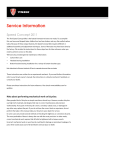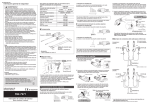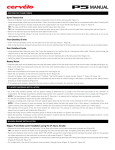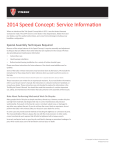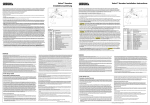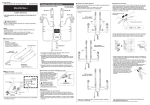Download Bontrager Aerobar Owner`s manual
Transcript
Part Number 253482 Figure 1- Bontrager Carbon Aerobar CARBON AEROBAR OWNER'S MANUAL Table of contents Read this manual before you ride .................................................................2 Inspect your handlebar regularly .................................................................2 Only use correctly installed bar-ends ...........................................................2 Adjust your handlebar for comfort ...............................................................3 Bontrager warranty.......................................................................................3 Handlebar installation instructions ..............................................................4 READ THIS MANUAL BEFORE YOU RIDE Please read this instruction manual thoroughly before using your new Carbon Aerobar. Also read the sections in your Bicycle Owner's Manual covering the handlebar and stem. These contain important safety and maintenance information. If you do not understand the information in this manual, or you have a question about your Carbon Aerobar that this manual does not cover, consult your Bontrager dealer. If you have a question or problem that your Bontrager dealer can’t handle, contact us at: Bontrager Wheelworks and Components Attn: Customer Service 801 W. Madison Street Waterloo, Wisconsin 53594 (920) 478-4670 http://www.bontrager.com © Copyright Trek Bicycle Corporation 2004 All rights reserved The handlebar, the part you hold with your hands when riding a bicycle, is primarily responsible for your ability to steer and control the bike. In addition, the handlebar works with the seat to define your posture on the bike, adding comfort and efficiency to your cycling. The handlebar is connected to the bike by the stem. This section explains how to inspect, adjust, and install your handlebar and stem. Inspect your handlebar regularly As with anything mechanical, every part of a bicycle has a limited useful life due to wear, stress, and fatigue. Fatigue refers to a low-stress force that, when repeated over a large number of cycles, can cause a material to fail or break. The length of the life of a part varies according to its design, materials, use, and maintenance. Although lighter parts may, in some cases, have a longer life than heavier ones, it should be expected that light weight, high performance parts require better care and more frequent inspections. Regularly inspect your handlebar for signs of fatigue stress: dents, cracks, scratches, deformation, or discoloration. Large forces can accelerate the fatigue of a material. As an example, a crash may add a great deal of extra stress to your bike. If you choose to jump your bicycle, use it for stunts, or ride it after a crash, carefully inspect your handlebar for signs of fatigue before and after each ride. If you are unsure of the safety of your Bontrager Carbon Aerobar, do not ride the bicycle; take the bicycle to your dealer for adjustments. Even if you perform regular inspections, be aware that if you exceed the limit of strength of a given part, it will fail. Unlike metal parts, carbon composite parts that have been damaged may not bend, bulge or deform; a damaged part may appear to be normal to a cursory glance. After any high force load, like a crash, or other impact to your bicycle, thoroughly inspect all the parts of your bike, and use the following procedures to inspect carbon composite parts. • Check for scratches, gouges, or other surface problems. • Check the part for loss of rigidity. • Check the part for delamination. WARNING A damaged carbon fiber part can fail suddenly, causing serious injury or death. Inspect a carbon fiber part for damage frequently. If you suspect a carbon fiber part is damaged, replace the part before riding, or take the bike to your dealer for service. Once a month make sure the stem is in alignment with the front wheel. Test the stem connection to the fork by attempting to turn the handlebar from side to side with the front wheel locked between your knees (Figure 2). Test the security of the handlebar by attempting to rotate it in the stem. Make sure that no cables are stretched or pinched by rotating the handlebar. Check that all bolts are tight. Remove the nut from the bolt or axle, clean the threads thoroughly, and apply a thread-locking compound (Loctite 242 is excellent). Tighten these bolts until the part is secure, but do not exceed the listed maximum torque: Figure 2 Function test the handlebar and stem 2 • Aero extension clamp bolts: 60 lb•in (6.8 Nm) • Elbow pad mounting bolts: 45 lb•in (5 Nm) • Stem clamp bolts: The correct tightness varies according to the type of stem on your bike. Check your bicycle owner's manual for these specifications. If you are unsure how to tighten these bolts, consult your dealer. Adjust your handlebar for comfort Handlebar position- the angle, width, and height of the handlebar- is largely a matter of personal preference blending comfort, efficiency, and balance. Your hands should be comfortable, and able to easily operate all controls. If your hands, arms, or shoulders are uncomfortable or numb you may need to adjust the handlebar or select components more suitable to your personal needs; consult your dealer. WARNING An improperly adjusted or tightened handlebar or stem may allow the handlebar to move unexpectedly, which can cause you to lose control and fall. Make sure the stem, handlebar, aero extension, and handlebar parts are positioned and tightened properly before riding the bike. To adjust the angle of the handlebar 1. Loosen the handlebar clamp bolt(s) on the stem just enough that the handlebar can be rotated in the stem. 2. Position the handlebar to the desired angle, making sure they are centered in the stem. 3. Tighten as in Inspect your handlebar regularly. To adjust the length of the aero extensions 1. Loosen the aero extension clamp bolt(s) on the handlebar just enough that the extensions can be moved. 2. Position the extensions to the desired length, making sure the ends of the extensions are within the clamp area (Figure 3). 3. Tighten as in Inspect your handlebar regularly. To adjust the width of the elbow pads 1. Loosen and remove the elbow pad mounting bolt(s). 2. Position the elbow pads to the desired position, 2. Reinstall the bolts, and tighten as in Inspect your handlebar regularly. To change the handlebar height Adjusting the handlebar height on a direct-connect stem affects the headset bearing adjustment. This procedure requires special tools and training so this should only be done by your dealer. Figure 3- Do not over-extend the aero insertion; the minimum insertion decal must remain exposed behind the clamp Carbon Aerobar installation instructions These instructions are written for an experienced mechanic. If you are not sure of your ability to correctly install this handlebar, or do not have the proper tools for installation, have the handlebar installed by your Bontrager dealer. To remove the old handlebar 1. Remove the old handlebar tape. 2. Remove the brake levers. Before removing the controls, note the path of the cables. 3 3. 4. 5. 6. Use an allen wrench to loosen the clamp screws on the control levers. Slide the levers off the handlebar. Loosen and remove the handlebar clamp screws. Remove the handlebar from the clamp. To install the Carbon Aerobar 1. Center the Carbon Aerobar in the stem. The bar angle is personal preference. 2. Install the handlebar clamp screws. 3. Gradually tighten the handlebar clamp screws until snug. Make sure the gaps at the top and bottom of the stem face plate are even. To install the aero extensions 1. Loosen the aero extension clamp bolt(s) on the handlebar. 2. Gently slide the aero extensions through the clamps. Note that there are left and right aero extensions. 3. Position the extensions to the desired length, making sure the ends of the extensions are within the clamp area (Figure 3). 4. Tighten as in Inspect your handlebar regularly. To install the control levers and bar tape Make sure no part has burrs or deformations which could scratch or damage the handlebar. 1. Slide the levers into position on the handlebar and connect the cables. 2. Tape the control cables to the handlebar with plastic or electrical tape. 3. Fully rotate the handlebar from side to side to test that the cables do not interfere with the steering. If the cables are too short, both the cables and housing should be replaced. Stand the bike up on the floor to check the position of the parts. 4. Set the angle of the handlebar, and tighten the stem clamp bolts. 5. Set the position of the controls and tighten the clamp bolts until the part is secure, but do not exceed 45 lb•in (5 Nm). 6. Install the handlebar tape. 7. Inspect the assembly as in Inspect your handlebar regularly. To install the elbow pads 1. 2. 3. 4. Select the position for the elbow pad holders. Install two screws in each elbow pad holder. Clean the surface of the elbow pad holder with isopropyl alcohol. Remove the backing from one of the sheets of hook-and-loop fastener, and apply the adhesive side to the corresponding elbow rest. Make sure it is centered and aligned before contact; once contact is made, the adhesive cannot be separated. 5. Firmly press the hook-and-loop sheet into position. 6. Repeat steps 4-6 for the other elbow pad. 7. Set the position of the elbow pads and tighten the bolts until the rests are secure. 8. Inspect the assembly as in Inspect your handlebar regularly. 4 WARNING Never modify your handlebar in any way, including sanding, drilling, filing, or by any other method. Improper components or improper assembly can place unknown stress on your handlebar or components. An improperly modified handlebar or component can cause you to lose control and fall. Before adding or changing any part of your bike, consult your dealer. Bontrager Carbon Aerobar crash replacement policy Assessing any damage done to a carbon fiber part requires more experience than is needed to inspect metal parts. If you crash your bike and the main force of the impact is absorbed by the handlebar, we strongly encourage you to replace the bar, even if there are no visual indications of damage. If this crash occurs within one year from the date of retail purchase, Bontrager offers a crash replacement program, substantially reducing replacement cost. To take advantage of this program, contact us using the information listed above, and ask for the Warranty department. Bontrager Limited Warranty Trek Bicycle Corporation warrants each new Bontrager component against defects in workmanship and materials. This warranty covers- Bontrager Carbon Aerobar for the a period of one year from the date of sale. This warranty does not cover• • • • Normal wear and tear Improper assembly Improper follow-up maintenance Installation of parts or accessories not originally intended for, or compatible with the component as sold • Damage or failure due to accident, misuse, abuse, or neglect • Labor charges for part replacement or changeover This warranty is void in its entirety by any modification of the component or its parts. This warranty is expressly limited to the repair or replacement of a defective item and is the sole remedy of the warranty. This warranty extends from the date of purchase, applies only to the original owner, and is not transferable. Trek is not responsible for incidental or consequential damages. Some states do not allow the exclusion of incidental or consequential damages, so the above exclusion may not apply to you. Claims under this warranty must be made through an authorized dealer. Proof of purchase is required. This warranty gives the consumer specific legal rights, and those rights may vary from place to place. This warranty does not affect the statutory rights of the consumer. 5





